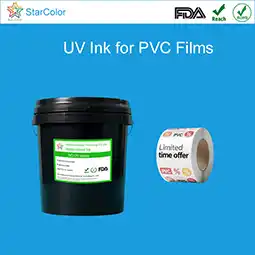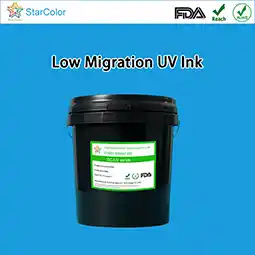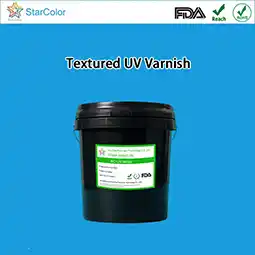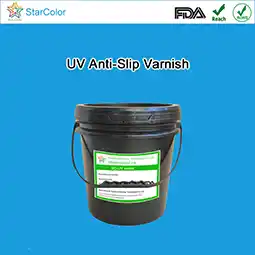UV Curing Mechanism and Applications of Flexographic UV Ink
Date: Jul 05 2023 From: Star Color Views:
Flexographic printing has become a mainstream technology in food packaging, labels, and flexible packaging due to its low equipment investment, wide substrate compatibility, and simple operation. Flexographic UV ink, specifically tailored for this process, combines the “fast UV curing” feature with the flexo requirements of low viscosity and smooth ink transfer, solving the weather-resistance limitations of traditional water-based flexo inks.
This article explains the formulation, UV curing mechanism, influencing factors, and application scenarios of flexographic UV inks.
1. Core Composition of Flexographic UV Ink
Since flexo printing relies on anilox rollers for precise ink transfer, the ink must offer low viscosity, excellent rheology, and rapid curing. Therefore, flexo UV ink is designed around “anilox-compatibility + efficient UV polymerization.” The formulation typically includes flexible UV resins, low-migration photoinitiators, reactive diluents, pigments, and functional additives.
• Flexible UV Resins
These are the main film-forming components, commonly polyurethane acrylates or polyester acrylates. They contain both flexible segments and unsaturated double bonds, ensuring strong film flexibility for thin substrates while allowing UV-initiated crosslinking. Resin viscosity is maintained at 500–1500 mPa·s to achieve uniform anilox transfer.
• Flexo-Grade Photoinitiators
Low-migration, fast-response photoinitiators are selected to activate rapidly at 365–395 nm wavelengths and support high-speed flexo lines (200–300 m/min). For food packaging, reactive photoinitiators are preferred because they chemically bond into the cured network without migration.
• Reactive Diluents
They reduce viscosity to 100–300 mPa·s for smooth anilox transfer while providing extra double bonds for crosslinking strength.
• Functional Additives
- 0.1–0.3% silicone-based defoamers prevent micro-bubbles during transfer.
- 1–2% leveling agents ensure smooth coating and avoid orange-peel defects on non-absorbent films.

2. UV Curing Mechanism of Flexographic UV Ink
Flexographic printing requires fast and stable curing to match anilox transfer and high printing speeds. The curing process consists of two tightly coordinated stages: pre-curing and main UV curing.
2.1 Pre-Curing Stage
After the ink is transferred to the substrate, it must complete leveling before reaching the UV curing zone:
- Ink levels within 0.1–0.2 seconds due to its rheology (thixotropic index 2.0–2.5), ensuring no visible anilox pattern.
- Some high-speed lines use a low-energy UV lamp for light pre-curing, forming a 0.5–1 μm surface film to prevent scuffing. Energy is controlled at 10–20 mJ/cm², triggering only minimal polymerization.
2.2 Main UV Curing Stage
When entering the main UV curing unit, more than 95% of polymerization occurs within 0.1–0.3 seconds, suitable for high-speed flexo production.
1. Photoinitiator Activation
LED-UV lamps (395 nm) or mercury lamps (250–365 nm) activate photoinitiators to generate primary radicals. LED-UV offers up to 40% higher efficiency and zero ozone emissions.
2. Chain Polymerization
Radicals attack the double bonds in resins and reactive diluents, triggering rapid chain reactions—thousands of reactions per second—without slowing down production speed.
3. Three-Dimensional Crosslinking
The polymer chains form a dense network that encapsulates pigment particles, achieving strong adhesion and friction resistance. The cured ink film reaches HB hardness and 5B adhesion.
2.3 Why This Curing Mechanism Fits Flexographic Printing
- Optimized low-viscosity design prevents anilox clogging.
- High-speed curing matches 200–300 m/min production without slowing down.
- Flexible resins prevent cracking on films, solving the brittleness issue of conventional UV inks.
3. Main Application Areas
Flexographic UV ink is widely used thanks to its fast curing, environmental compliance, and broad substrate compatibility.
3.1 Food Packaging Printing
Suitable for snack bags, frozen food packaging, and beverage labels requiring low migration (≤0.1 mg/kg) and low odor.
The Starcolor SC-UV flexographic UV ink series features only 8 g/kg VOCs and complies with SGS food-contact testing (specific migration ≤0.008 mg/kg). On BOPP film, the cured film withstands boiling at 100°C for 30 minutes without peeling and remains crack-free after -20°C freezing for 24 hours.
3.2 Label Printing
Ideal for cosmetics, pharmaceutical labels, and other high-precision applications.
- Dot gain ≤6% at 175 LPI
- Color difference ΔE ≤0.6
- 50 alcohol wipes without fading
- Over 1000 abrasion cycles under 500 g load
3.3 Soft Packaging & Non-woven Materials
For PE films and non-woven shopping bags where flexibility is crucial:
- Ink film elongation ≥20%
- No cracking after 100 folds
- 5B adhesion on non-woven substrates
- No odor, compliant with indoor air standards (GB/T 27630)
3.4 Paper Packaging
Used in pre-printing cartons and gift boxes. UV curing eliminates long drying times, reduces workshop space, and high solids lower ink consumption by 20%.
4. Future Trends
Flexographic UV ink is evolving toward:
- Lower-energy curing for reduced power consumption
- Safer low-migration photoinitiators
- Functional inks (antibacterial, anti-counterfeit, etc.)
- Wider adoption of LED-UV for 30%+ energy savings
For enterprises, three implementation recommendations are crucial:
- Select ink matched to anilox line count and substrate (Starcolor provides PP-grade, paper-grade, etc.).
- Establish a coordinated tuning system involving anilox, ink, UV energy, and printing speed.
- Maintain UV lamps and anilox rollers regularly to ensure stable curing.
Conclusion
The UV curing mechanism of flexographic UV ink represents a perfect combination of flexographic process requirements and efficient UV polymerization. It meets environmental regulations while improving productivity. As flexographic printing continues to grow, flexographic UV ink will remain a key technology for enhancing competitiveness in the packaging industry.
 RU
RU EN
EN CN
CN















